
by PETER MILTON
It’s almost a truism that 78-rpm records are becoming very "collectible." There is scarcely a flea market or garage sale which does not have its quota of dusty old discs and early phonographs. Even old cylinders turn up. I recently rescued a pile of almost mint Edison Diamond discs from a decorator who was intent on nailing them to a steakhouse wall. If you consider that in 1927, just before the record industry started to decline, over 100 million records and nearly one million phonographs were sold in the United States alone, and that in 1946, 400 million records and nearly 3 1/2 million radio-phonograph combinations were sold, you will understand why there are so many survivors.
There are still sufficient early records and phonographs to keep a reasonably representative collection affordable, although if your interests run to the quality machines, a good cylinder model, with an external horn made from oak, can cost you $2,000. Many audiophiles will be surprised to find that the restoration and collection of machines and records from earlier days almost amounts to a "subculture" which seems to have very little in common with mainstream hi-fi.
There are several flourishing antique phonograph societies, whose ranks include mechanically minded tinkerers who delight in restoring very early phonographs, serious minded collectors who are intent on preserving part of our technical history, and those who simply want to enjoy the music of an earlier era. Each aspect attracts its specialists; collectors of old cylinder machines, for instance, are not particularly interested in the art of restoring the sound from discs.
You might have, as I do, a collection of 78s kept from the pre-microgroove days, which were too important to discard but which were never reissued in the new format. Perhaps you have bought a pile of old discs and are curious to know how they sound. Our present technology makes it possible to reclaim most of the sound recorded in the old grooves with a degree of fidelity which would astound their original owners. Often the biggest problem is finding a turntable with the 78-rpm option.
There are purists who say that these discs sound best on the original machines. However, the masters always contained more information than the reproducers could extract, and there is little point in subjecting the grooves to stylus pressures of a half pound and more.
Looking back from our digital recording vantage point, it is tempting to say that the old records were noisy, distorted and, for all practical purposes, alike. There are obvious differences between cylinders and discs, but even among the latter there were wide variations. The most common sizes were 10and 12-in. diameters, but many early discs were issued in sizes ranging from 5 1/2 in. upwards. Even 20-in. diameter discs can sometimes be found.
The speeds also varied wildly. The predominant speed by 1925 was 78 rpm, used by Victor, which happened to be making the most records at the time. Edison used 80 rpm, as did Columbia and Okeh, and some Pathé discs were even recorded as high as 90 rpm. You might even come across some 1931 Victor records recorded at 33 1/3 rpm.
When electrical recording started in 1925, 78 rpm was adopted for compatibility with as many discs as possible. In truth, the record speed was relatively unimportant since most phonographs had a speed control and the pitch was adjusted to the listener's taste.
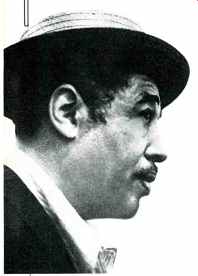
--- Duke Ellington and The Andrews Sisters (CBS Photo).
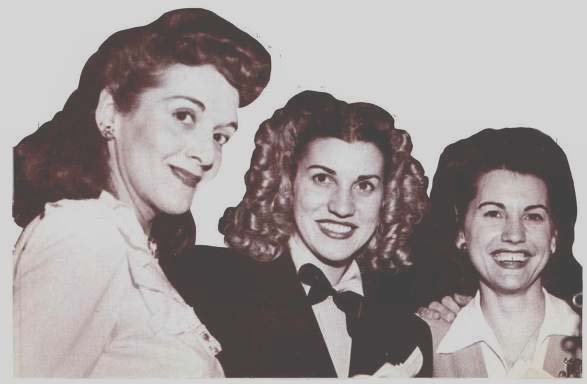
It turned out that in order to use a simple worm gear with a 60-Hz synchronous motor, the actual speed was 78.26 rpm. If you wish to make a strobe for 78.26 rpm, using a 60-Hz line, the formula for the number of dots, N, is: N = 72.00 rpm which gives 92 dots for 78.26, 216 for 33 1/3 and 160 for 45 rpm.
Before electrical recording made it necessary to standardize the speed, variations existed not only between companies but even between discs from the same studio. By replaying early discs to give the known pitch of early artists, variations of as much as 10 rpm can be found between recordings made on the same lathe. For this reason, a variable speed player is essential for old records.
There are also some old changers which can be picked up fairly cheaply.
You should realize that the center hole was not standardized completely and present-day automatic changers can jam on early discs. If you happen to have a record which plays from the inside out, the trip mechanism will be very frustrating to say the least.
It's probably best to modify the deck radically to make, in effect, a standard manual turntable. Disconnect the trip mechanism and remove any side posts so that oversize records can be played. Before the early '60s, the tone arms were usually heavy clunkers with large amounts of bearing friction and no anti-skating adjustments. "The Ancients" recognized the problem of the inwards force due to the offset angle and overhang of the stylus and called it "side-thrust" in those days. To quote the Radiotron Designer's Handbook (F. Langford Smith, Editor) published as late as 1953, "A moderate amount of side-thrust is not detrimental, because it helps to overcome pivot bearing friction...." A lightweight pickup with a miniature needle played at about 3/4 ounce of tracking force as compared with the half pound plus of the soundboxes and early electrical phonographs, so the bearings did not need to be as good as present cartridges demand.
It makes sense to use a modern low distortion, wide-range cartridge for the old 78s. The earlier pickups had needle tip resonances well within the audio range, with a 12- to 15-dB spike at 15 or 20 kHz not uncommon for a lightweight pickup. Also, intermodulation products increased the noise in the lower part of the audio spectrum.
A modern cartridge is smooth right through the audio range, and 78 tips are available for most cartridges.
Shure has a dozen in their range, from the N44-1 for the M44, at $12.25, to the VN478E at $64. If you intend to get into the 78 side of things seriously, Stanton will be able to help considerably since they produce a full line of cartridges for studio use. The 500 cartridge with the D5217 is very robust and can cope with playing weights of up to 7 grams.
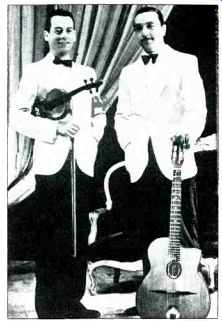
--- Stephane Grappelli and Django Reinhardt
A modern cartridge needs a good arm if it is to function well, though it is outside the scope of this article to survey a wide range of arms. I have used an SME arm in its various forms since they were first introduced and although the knife-edge arrangement has been a little balky at times, I have found that this arm has stood up to long periods of laboratory use. My current choice in arms would be the SME 3009 R. The headshell in this model is removable, which helps considerably if you use several different cartridges.
The increased interest in 78s has also been noted by several turntable manufacturers, and Thorens offers the TD-126 IIIB, an excellent choice. If you are fortunate, you may be able to find a Lenco variable-speed turntable, which can, if need be, wind at speeds up to 90 rpm. Collectors know the value of the Lencos and they are becoming rare. Dual's CS-608 is a three speed automatic turntable which I had a chance to check for a review last year. It is a moderately priced machine, sporting a lightweight arm with the Dual anti-resonance filter. The controls are placed conveniently outside the dust cover, and its styling allows it to blend unobtrusively with other hi-fi components. Depressing either of the two speed buttons gives a choice of normal 33 1/3 or 45 rpm; depressing both buttons selects the 78-rpm speed. A cartridge is supplied with the turntable, and a stylus for 78-rpm recordings, using a 2.6-mil tip, is available. The Dual machine is unique because it is the first hi-fi turntable in several years to have the 78-rpm option and a moderate price.
A turntable rotating at the correct speed and a cartridge with a 2.6-mil stylus are the very minimum requirements for playing old 78 records. We live in a world which has the luxury of international standards, and because an item is of a standard size today, we tend to think that it was always so. In the latter days of 78s, the groove was standardized so that today's "standard" styli could trace a new 78 groove without touching bottom. At the same time, the radius was small enough to allow the stylus to ride in the groove without jumping. This is a great idea, provided that the disc is in perfect shape and has been cut to the standard shape.
Unfortunately, today's standard stylus tends to float in the bottom of the wide, shallow Pathé record grooves and ride on the top of the narrow groove Edison high-speed discs. One remedy is to use a truncated tip, which allows contact with the groove walls but does not reach the noisy groove bottom. In addition, even if the groove was cut to present-day standards, a steel needle soon chops out its own path, leaving a crop of filings embedded in the walls for good measure. The truncated tip and a selection of styli of differing radii should be part of the toolkit of a serious audio historian. Perfect tracing is the key to good sound from old records just as in the very latest digital types. The GIGO rule still holds: no amount of subsequent treatment can remove the distortion caused by poor groove tracing.
The steel needle was not the only groove-tracing device in use. Both diamond and sapphire were frequently employed and in fact, Edison employed a 0.75-mil diamond tip for his Blue Amberol cylinders. It is fairly safe to assume that all the discs you are liable to meet will be either hill-and dale or lateral types. Victor Emerson, at the turn of the century, did introduce a cutter which produced 45-degree modulation in an attempt to produce a compatible record for both types of soundbox (and getting round Edison's strong patents on the vertical process), but the issue was very short-lived. It is fairly obvious that a standard stereo cartridge will reproduce both types, but there are two very practical objections. The first is that surface noise is a product of contact with the roughness of the groove wall and produces random motion in both the vertical and the lateral planes. A stereo cartridge responds to noise from all directions but produces the signal from only one. Consequently, the signal-to-noise ratio is unnecessarily degraded. The second objection is particularly important for laterally cut grooves.
The groove has always been cut by a chisel-shaped cutter, operating at a constant groove depth. Therefore, although the groove is always the same width along the radius of the disc, the effective groove width (in terms of what the stylus tip sees and must negotiate) varies, being widest at the crest of the wave and narrowest at the zero crossings. This causes the stylus to ride up and down in the groove twice per cycle. The narrowing of the groove gives the name "pinch effect" to the consequent distortion, which is primarily second harmonic in nature.
Many solutions were found for this problem, all centered on eliminating the output in the vertical plane, and ranged from cartridges which were completely rigid vertically, and cartridges with a fairly rigid stylus bar on a pivot permitting only lateral movement, to long flat cantilevers which rode over the vertical movement without transmitting its effect, like a good set of shocks.
The easiest solution, since we are now blessed with a stereo cartridge, is to link the two positives and negatives together for lateral recordings and to parallel the two channels but with one side reversed for vertical discs. A switch can be installed at the base of the tonearm, or if you have two cartridges, the wiring change can be made in the headshell.
It is possible to use the stereo/mono switch and a phase reversal switch if one exists on the preamplifier, but not advisable. The unavoidable phase changes in the input section of the preamplifier tend to prevent complete cancellation between channels; the result usually sounds much cleaner if the connections can be made close to the cartridge.
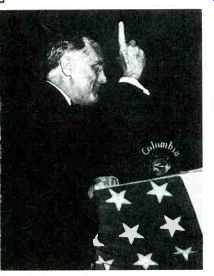
--- Franklin D. Roosevelt (CBS Photo)
The noise coming from the early discs is primarily caused by the material used for the pressing. The plastics industry was in its infancy at the beginning of the century, and the most urgent need was for a hard material which would stand up to the pounding of the heavy sound-boxes. Many materials were tried, from celluloid and hard rubber to Bakelite.
Shellac, a product of an insect native to India and the Far East, produces relatively quiet, smooth surfaces but is easily destroyed during the first few playings. Shellac in 78s was reinforced with Indiana limestone and Pennsylvania slate, materials calculated to resist wear and grind the stylus down to the shape of the groove. Bits of the needle, left behind in the groove, add to the overall noise, and the method of harvesting the shellac left a lot to be desired. The insects (Carteria Lacca) were scraped off twigs and were shipped, along with bits of bark, sand and other tropical rubble, to be ground up for the basic record material. In addition, when shellac became more difficult to obtain, up to 25% reclaimed material, including the record labels and any bottles that happened to be thrown in with the day's garbage, was mixed in. The quality of the record material was variable, to say the least.
The whole pressing and reproducing process naturally left a considerable amount of debris in the groove.
Not all of it will be steel filings. Careful music lovers used to use fiber or thorn needles to protect the grooves, and custom-made jewel needles were available.
I once asked a record dealer for the best way to clean and restore old 78s.
His reply was that the needle would push the dirt aside as it travelled the groove, so there was little need for cleaning. I did not have that reply in mind, since a modern cartridge, playing at one gram, would skate over the particles and so produce more noise.
The standard method is to scrub the records lightly with a mild detergent, followed by thorough rinsing. If records need sprucing up and have a lot of fingerprints, they might be cleaned with a window cleaning spray such as Windex. The important thing is not to do more damage to the records than has already been done.
I have a spare Watts Manual Para stat and have found that the nylon brush at the center does a fine job of dislodging debris. A mild detergent works very well, but if you wish to be really scientific, Discwasher's Special Shellac Formula, which has been developed specially for 78s, gives excellent results. If you use a brush or a felt pad for your 78s, label it clearly and keep it just for that purpose. If you accidentally use it on your vinyl discs, there is a risk of particles embedded in the fibers damaging the grooves.
Shellac discs are very fragile and broken records can be a problem. Edison made his Diamond discs a quarter inch thick, which helped to preserve them, but the thinner 12-in. Victors break easily. I asked my dealer friend how to mend a broken disc. Like a true salesman, he suggested that since his network of associates could probably locate a replacement within a few days, it would be a lot less trouble to throw the pieces away. There is a solution for clean breaks, however. Two pairs of hands are needed for the repair, which only works if the grooves are intact.
Place the pieces on a flat surface and fit them together carefully. In most cases it can be done so that the crack is nearly invisible. Holding the parts together with a slight pressure, apply a spot of instant cement, Krazy Glue for instance, to the outer guard band and to the center near the label, being careful to avoid the grooves.
Capillary action will draw the glue down into the crack, where it will set.
Do not be tempted to put the glue on the broken edges before fitting them together because the glue's extremely rapid setting makes it almost impossible to make any fine adjustments.
When the first side has been glued, turn the record over and apply the glue to the other. With a bit of care and a lot of luck, the crack will be largely inaudible.
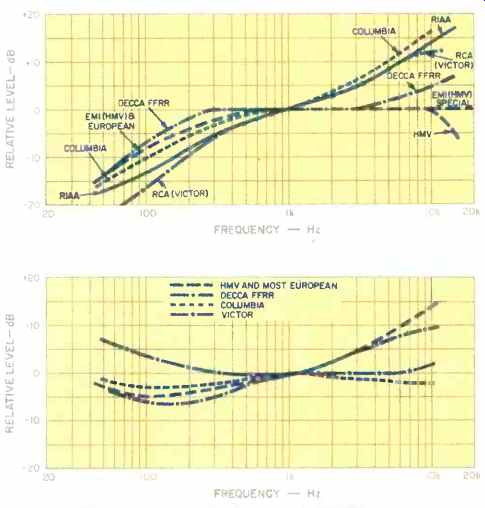
Fig. 1-Recording characteristics used by various producers of 78-rpm records
and their deviation from the present-day RIAA curve.
Fig. 2-Tone control or equalizer settings required, after RIAA "de-emphasis," to flatten the various recording characteristics.
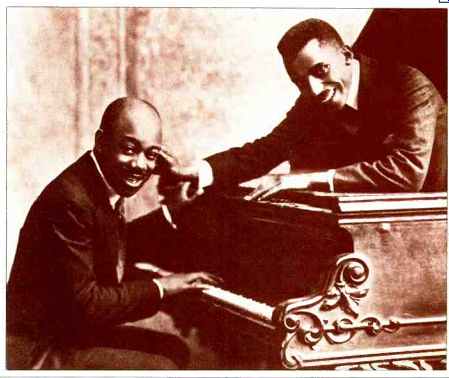
--- The Dixie Duo, Eubie Blake and Noble Sissle; below, Les Paul at
age 11.
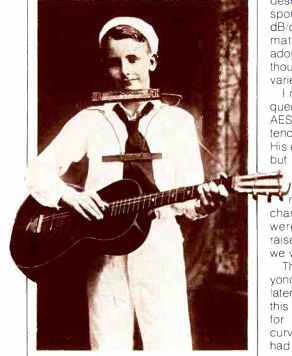
---
Once the purely mechanical aspects of providing the correct turntable speed and stylus type have been settled, the more interesting part of adjusting the sound quality can begin.
The early presses were not sophisticated and the temperature of the machine, the pressure, heating and cooling cycles were completely under the control of the individual operator. Conditions could change during the course of the day; the ambient temperature could change, and operator fatigue could alter the cycle time. Because of these factors, the tone quality of the records used to vary, even when taken from the same batch. To add further to the confusion, the recording characteristics were not formalized until very late in the history of 78s--almost with their dying gasp, in fact. This requires either a very forgiving ear or a preamplifier capable of six or seven different equalization curves.
Every 78-rpm record will require its own tone control settings and special treatment. You might even find that two different styli are needed to extract the best sound from the groove. The easiest course is to tape your results once you are satisfied with them. Be sure to connect the deck to an EQed output of the preamplifier, since the normal connection bypasses the tone control in many preamps. The correct frequency equalization is just as essential for 78s as it is for vinyl discs. The difference is that there was no general agreement on which curve should be adopted.
Today we have the luxury of being able to press the button marked "phono" and know that any record made during the last 25 years will be equalized to within a dB or so of the nominally flat frequency response required by the rest of the system.
In their classic paper on electrical recording in 1926, Maxfield and Harrison pointed out the need to record at constant velocity at low frequencies to conserve space, and to pre-emphasize the highs to improve the signal-to-noise ratio. The recording system they described had a flat frequency response extending out to 6 kHz and a 6 dB/octave roll-off starting at approximately 250 Hz. Most companies adopted this, particularly in Europe, although the turnover frequency was varied between 200 and 300 Hz.
I raised the question of turnover frequency with a fellow member of the AES whose recording experience extended well into the days of the 78s.
His comment confirmed my suspicions but did not help my search for useful standards.
"We adopted 250 to 300 Hz as a rule," he said, "but our recording characteristic depended on what we were trying to do. Sometimes we raised the turnover to 500 Hz or more if we wanted a quieter recording." The hill-and-dale records went beyond 6 kHz in 1926, as did some of the later acoustical lateral-cut discs, but this can be taken as the starting point for the early Victors. The standard curve, published by HMV in Europe, had a 250 Hz roll-off and was -3 dB at 13 kHz, with the special recordings extending to 20 kHz.
When these records are played back using equalization intended for stereo discs, the high frequencies require a considerable amount of boost to compensate for the RIAA roll-off, and the difference in the bass turnover frequencies causes a rise in output of about 6 dB between 100 and 200 Hz.
The Decca Record Company adopted the treble pre-emphasis suggestion and boosted the highs by 6 dB at about 12 kHz and used a turnover frequency of just under 200 Hz.
In the United States, the high frequency pre-emphasis was adopted wholeheartedly, and a characteristic very similar to the RIAA was used above 1 kHz. Columbia used a turnover frequency of 300 Hz, but Victor used about 600 Hz.
Figure 1 shows the recording characteristics plotted in the normal way for the most common European and American records, and for the sake of comparison I have included the RIAA curve. Figure 2 is a more useful adaptation of Fig. 1. I assumed that the regular RIAA equalization would be applied to the record and, by showing the difference between the RIAA and the nominal 78 curves, obtained the control settings required to bring the 78 discs back to a flat output. For instance, the 250 Hz turnover frequency used by HMV produces +5 dB with respect to the RIAA curve when referred to 1 kHz, and so requires a reduction of 5 dB at this frequency. The high frequency lift is quite beyond a current preamplifier, although the full lift, without a steep cut filter to remove the worst of the surface noise, would be intolerable.
The serious audio archaeologist will find that a separate equalizer is essential to the restoration of old discs. A single octave equalizer is only of limited use, since in addition to compensating for the different record characteristics, a sharp band-stop filter is extremely useful for removing the resonances and blasting effects which seemed to abound. A 1/3-octave graphic equalizer is much more useful since the visual display will allow you to set the equalization to the curves of Fig. 2 very easily and the bandwidth of the system can be adjusted to suit the frequencies actually recorded. There is no point in following the theoretical curve out to 10 kHz if there is only needle scratch. My most useful piece of equipment for the restoration of the sound is Technics' SH-9010 Stereo Universal Equalizer. There are five bands on this unit, each band capable of being shifted from 1/3 to 3 times the nominal frequency. The bandwidth can be altered so that the Q factor ranges from 0.7 to 7.0, and the boost or cut is variable over a range of 12 dB. If five overlapping bands are insufficient, then the channels can be cascaded to give 10! One side can be used for accurate equalization, and the other can be used to chase out resonances. The disadvantage of this machine is that I found it so much fun to use that I spent more time setting it up than listening to the records! Expanders have their uses, and of the currently available units I would suggest the dbx 3BX. Expansion should be used with caution to avoid unnatural effects, but when used discreetly in the highs, a lot of the hiss can be tamed. You might find the compression feature an advantage. In the early days of acoustical recording, some of the singers used to lean towards the horn when they were belting out the high notes. If these coincided with the resonances in the horn, an unnatural blasting effect occurred.
This can be tamed to some degree by compression. It seems that the recording engineers of those days had to resort to manual compression. If the soprano would not allow for the limitations of the machine, the engineer would sometimes rush out just before a crescendo and haul her away from the horn!

--- a The original Benny Goodman Four at a recent Newport Jazz Festival
(Photo: George Gilmore); below, The Mills Brothers (CBS Photo).

---
I have also found Phase Linear's Model 1000 Series II noise-reduction system very useful for removing the hiss. The auto correlator system examines the frequency content of the signal as it passes through the preamplifier and reduces the bandwidth for low-level notes, so that the hiss is removed. At higher levels, where the hiss would be effectively masked, the bandwidth remains untouched. The threshold of operation can be adjusted, which makes the unit a very useful tool for restoration. I found that I had to approach the expansion feature with some caution, since it operates over the entire band and can bring out the clicks and pops. But then you can always add a click and pop remover.
I have been secretly disappointed recently. Hi-fi has approached perfection so closely that tinkering at home seems pointless. It was a thrill to be the first person on the block with a home-made electrostatic speaker and a Williamson amplifier, and this era is certainly long since passed. I am familiar with digital techniques and am looking forward to living with a DAD player and a digital cassette machine.
I admire the perfection in audio which they promise and look forward to being freed from the need to worry about the quality of my signal source. But, you know, tinkering with those cranky old discs has brought a whole new dimension to audio. It is spelled F U N. And that, to me, is what a hobby should be about.
========================
(adapted from Audio magazine, Jun. 1986)
= = = =
Also see:
Noise Reduction--Side Benefits & Side Effects (Apr. 1983)
The DNR Noise Reducer: How it Works and How to Build it. (Feb. 1985)